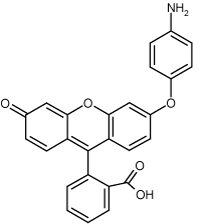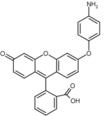Fluorescent reagent (Ex(max): 490nm; Em(max): 515nm) for the detection of highly reactive oxygen species (hROS). Immediately reacts with hROS such as hydroxyl radical, peroxynitrite and hypochlorite, and the fluorescence intensity greatly increases. Use of APF together with HPF (Prod. No. ALX-620-074) also allows for specific detection of hypochlorite (-OCl) to elucidate reliable the roles of -OCl in biological systems such as neutrophils. In addition, peroxynitrite can be detected in distinction from nitric oxide and superoxide since APF does not react with nitric oxide, superoxide and hydrogen peroxide. Moreover, APF is resistant to light-induced autooxidation. Not for sale in Japan.
Product Details
| Alternative Name: | Aminophenyl fluorescein, 2-[6-(4'-Amino)phenoxy-3H-xanthen-3-on-9-yl]benzoic acid |
| |
| Formula: | C26H17NO5 |
| |
| MW: | 423.4 |
| |
| CAS: | 359010-70-1 |
| |
| Concentration: | ~5mM |
| |
| Formulation: | Dissolved in 0.47ml dimethyl formamide. |
| |
| Purity: | ≥98% (HPLC) |
| |
| Appearance: | Pale yellow liquid. |
| |
| Shipping: | Blue Ice |
| |
| Long Term Storage: | +4°C |
| |
| Use/Stability: | Prepare 500-5’000-fold dilution (~10-1µM) in phosphate buffer (0.1M phosphate, pH 7.4) immediately before use. BSA, phenol red and amines may affect the fluorescence and must be used with caution. Do not store the dilutions. |
| |
| Handling: | After opening, prepare aliquots and store at +4°C. Protect from light. Keep under inert gas. |
| |
| Regulatory Status: | RUO - Research Use Only |
| |
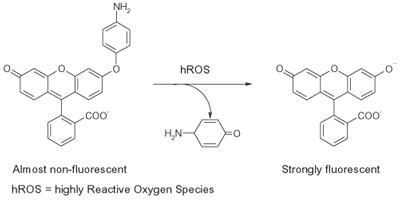
Figure 1: Reaction of Aminophenyl Fluorescein (APF) with hROS.
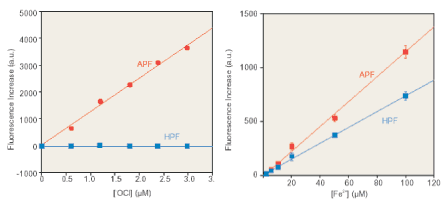
Figure 2: HPF and APF enable the selective detection of highly reactive oxygen species and they are hardly autoxidized by light irradiation. Left panel: detection of -OCl.Right panel: detection of •OH generated by the Fenton reaction.

Figure 3: Light-induced autoxidation. Compared with DCFH, HPF and APF were hardly autoxidized by light irradiation.

Figure 4: Fluorescence images of HPF- or APF-loaded neutrophils. The fluorescence intensity of HPF-loaded neutrophils was not changed upon stimulation with PMA whereas that of APF-loaded neutrophils greatly increased. This suggests that -OCI produced by MPO (myeloperoxidase) upon stimulation with PMA could be selectively visualized in distinction from other ROS.
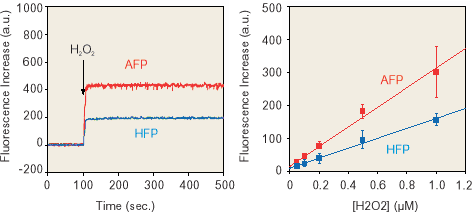
Figure 5: Detection of hROS in the HRP/H2O2 system using HPF and APF. The fluorescence intensity increased immediately upon the addition of H2O2. Further, it was found that HPF and APF could detect hROS generated in the HRP/H2O2 system in a dose-dependent manner.
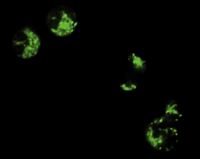
Figure 6: Fluorescence image of hypochlorite (-OCl) which was generated in porcine neutrophils using APF.
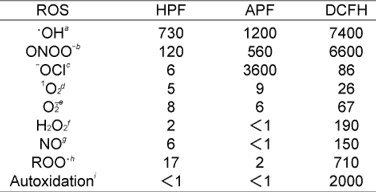
Figure 6: Fluorescence probe reagents were added to sodium phosphate buffer (0.1M, pH 7.4) (final 10µM; 0.1% DMF as a cosolvent). The fluorescence intensities of HPF, APF and DCFH were measured at excitation wavelength of 490, 490 and 500nm and fluorescence emission wavelength of 515, 515 and 520nm, respectively.
a 100µM of Ferrous perchlorate (ll) and 1mM of H2O2 were added.
b 3µM (final) of ONOO- was added.
c 3µM (final) of NaOCI was added.
d 100µM of 3-(1,4-Dihydro-1,4-epidioxy-1-naphthyl)propionic acid was added.
e 100µM of KO2 was added.
f 100µM of H2O2 was added.
g 100µM of 1-Hydroxy-2-oxo-3-(3-aminopropyl)-3-methyl-1-triazene was added.
h 100µM of 2,2
Please mouse over
Product Literature References
Gas Flow Shaping via Novel Modular Nozzle System (MoNoS) Augments kINPen-Mediated Toxicity and Immunogenicity in Tumor Organoids: J. Berner, et al.; Cancers
15, 1254 (2023),
Abstract;
Modeling Gas Plasma-Tissue Interactions in 3D Collagen-Based Hydrogel Cancer Cell Cultures: L. Miebach, et al.; Bioengineering (Basel)
10, 367 (2023),
Abstract;
Development of novel fluorescence probes that can reliably detect reactive oxygen species and distinguish specific species: K. Setsukinai, et al.; J. Biol. Chem.
278, 3170 (2003),
Abstract;
Related Products




